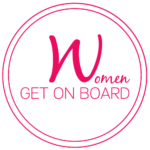Women Get On Board Inc. (WGOB) is a member-based company that connects, promotes and empowers women to corporate boards.
On October 25, WGOB hosted the second part of the ESG series of their virtual WGOB Speaker Series, sponsored by UBS. The fireside chat focused on the “S” of ESG—social issues—exploring what they are, why they’re important, and how such issues should be addressed at the board level.
To begin the event, Deborah Rosati, FCPA, FCA, ICD.D, GCB.D, Corporate Director and WGOB Founder and CEO introduced Aneliya Crawford, Managing Director at UBS Investment Bank and leader of UBS’s ESG Advisory Group efforts for the Americas.
Then, Aneliya welcomed Mary Larson, Partner at MNP Consulting and leader of the firm’s National Organizational Renewal Practice, to contribute her extensive expertise on the “S” of ESG.
The pair kicked off the conversation by defining what we mean when we talk about social issues. As Aneliya pointed out, this aspect of ESG might be the one that business leaders struggle the most to understand, perhaps because it is difficult to conceptualize the scope of the issue as it relates to corporate operations.
What does the “S” mean for corporate governance?
At first glance, it may be difficult to see why the “S” dimension of ESG should be on the board’s agenda. It’s tempting—especially in the current moment—to focus only on the “E” in ESG, concentrating efforts on fighting the very real threat of climate change. However, Mary and Aneliya made the convincing case that social issues require the attention of corporate leaders and board members because they affect nearly every aspect of the business.
Mary explained that social issues have an expansive impact on corporations, both on an internal and external level. Internal social issues at an organization include working conditions and worker safety, customer privacy, equity, diversity and inclusion (EDI) and culture. External issues include modern slavery and human rights, both of which impact corporations directly. Upon closer examination, it’s immediately clear why these topics might have a place at the boardroom table.
“Most of these issues are highly measurable and tangible,” said Mary.
How do social issues impact companies?
A range of social movements are impacting companies right now. In particular, Mary pointed to the #MeToo movement, which highlights slippage in gender equity at companies, anti-Black and anti-Indigenous racism, modern slavery and concerns over privacy.
She also highlighted poignant headlines that have drawn attention to social issues at corporations. The 2013 collapse of a Joe Fresh factory in Bangladesh that killed 1,135 garment workers made a lasting impression on consumers, who began to demand that companies provide safer working conditions throughout their supply chains. And despite stricter regulation, modern slavery continues to persist, with an estimated 25 million people worldwide still trapped in forced labour. High-profile data breaches continue to make the news as companies fight to protect customer data from hackers. These are just a few of an extensive and growing list of social issues that intersect with the corporate world.
Why should companies take action on social issues?
Aneliya pointed out that a common refrain she hears from corporate leaders is that they don’t consider addressing social issues to be the role of the private sector. Although tragic, why is it the job of companies and not governments?
Mary’s answer is simple. Social issues affect business, directly and indirectly, every day.
“The risks to your company if you don’t pay attention to these things are enormous,” she said.
This is particularly true for EDI, which has become a hot-button issue in business circles recently. Mary explained that if organizations expect to attract and retain top talent, they must address equity, diversity and inclusion. People want to work at companies that are diverse, and they want to bring their whole selves to work. If companies develop a reputation for being unwelcoming to women or to people from diverse backgrounds, people will leave, and it may become difficult to hire new talent. As most leaders know, churn has a cost, as hiring is expensive and time-consuming.
Worker safety, data breaches and forced labour are other examples of issues that directly affect business operations. It’s necessary to demonstrate to shareholders and customers that your company is addressing these risks because they will undoubtedly affect future success.
“These issues get in the way of business,” said Mary. “They’re getting in the way of hiring people, buying the goods you want to buy, selling the things you make, and keeping customers.”
Who should be responsible for social issues?
Thinking on this topic has evolved in the past few years, and social issues are no longer only the responsibility of a specific department or individual. In modern companies, everyone at the organization is responsible for addressing social concerns, from the C-suite to the mailroom.
In practice, this means that culture is more integral than ever before. Companies should measure and manage their corporate culture, recognizing that it can make or break their performance on ESG issues, particularly in the social realm.
And, of course, the action starts with leadership. Boards and executives must be well-informed on social issues so they can address them successfully and get ahead of potential risks.
What is the role of the board?
Aneliya commented that—contrary to popular belief—the impacts of social issues on companies can be quantified. That’s where the board comes in.
To manage social issues, board members should request the information they need to make good decisions. First, they should request culture measurements that go beyond engagement surveys. Then, they should ask for data on other topics related to social issues that affect their specific organization. These measurements could include internal audits, demographic surveys to measure diversity, accident reports and detailed reporting on incidents of discrimination.
“What I’m seeing is that boards are really starting to do some interesting things to address social issues,” said Mary. “They are taking on some very hard responsibilities and demanding data.”
In addition to requesting information, boards should also be asking tough questions to get to the root of social issues at the company. Where are we buying materials? Where are we selling them? Who are we selling them to? How are we protecting our customer data? How are we protecting our workers?
Aneliya also had a few more suggestions for board members. She recommended that boards ensure these topics are not siloed in the HR department without any direct connection to business operations or reporting to the CEO, and she suggested matrixes to ensure that leaders in specific roles are included.
Similarly, Mary suggested that boards avoid keeping social issues contained to a separate ESG committee. Instead, she proposed that every board committee completely overhaul their mandates, rewriting them to incorporate oversight around social issues. The Chair, especially, should be responsible for ensuring that these topics are discussed, addressed and reported on appropriately.
Conclusion
Increasingly, social issues are finding their way into the boardroom as leaders recognize the monetary, reputational and regulatory risks associated with them. As part of their fiduciary duties, it’s critical that board members understand and address these topics proactively.






